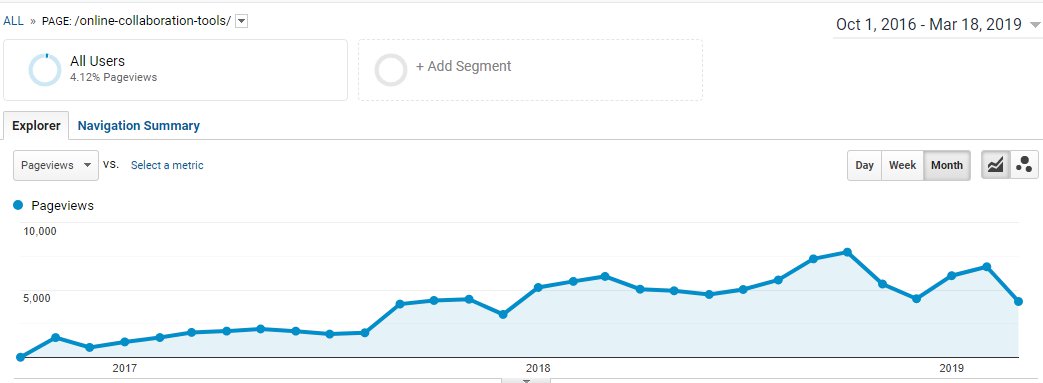At Time Doctor, our best (and favorite) marketing channel is content focused SEO.
A few years ago, we had noticed that the majority of our signups and traffic came from a few keywords.
So, we went all in.
The result?
At the time of this writing, our website, TimeDoctor.com receives over 200,000 visitors per month and over 8,000 signups per month.
Our marketing team has grown from 3 to 11 people located all across the globe, from the U.S. to Canada, to the Philippines.
In this post, we’re going to share how we hire members for the SEO team, track our key performance indicators (KPI’s) and how we set the team up for success.
Liam Martin and Greg Digneo created a course to help folks who want to start an SEO based marketing campaign like the one we’ve set up at Time Doctor. Check out the first video where we talk about our experiences with SEO and how it’s changed our business.
Who is this post for?
You’ve seen the success that we’ve had with SEO and maybe you want to replicate that for your business.
But here are a few caveats I want to warn you about before you jump in and commit to setting up your SEO team.
First of all, SEO isn’t a business model and it won’t overcome a poor product. If your product or services isn’t good, or is something that no one wants, then do not spend a single cent on SEO.
Second, this post is for those who are able to commit to investing long term. Getting to over 200,000 visitors didn’t happen overnight and it didn’t happen without mistakes being made.
SEO is and always will be a long game play. But once you have it all set up, you’ll have a never ending supply of traffic and qualified leads for your business.
Third, to get the most out of this post, you need to have a working knowledge of what SEO is and how it works. This post is NOT an SEO tutorial. (For instance, more backlinks to a post is good!)
And finally, you’ll need to experiment. A lot! You can use what we’ve done as a blueprint for our SEO success, but you may need to tweak some of the strategies to work best for your business.
Why did we choose SEO as our primary marketing focus?
Back in October, we published a post called “53 Best Online Collaboration Tools” where we simply listed the online collaboration tools that we found can help remote businesses.
We did a bit of promotion and spent a few months building links.
These days, the post gets over 5,000 visits per month and over the 2.5 years since it was published the post has been viewed over 115,000 times.
To put that in perspective, if we were to pay for that same traffic in Google, we would have to pay $2.9 million. (According to adwords, the two primary keywords we rank for “online collaboration tools” and “collaboration tools” cost $25 per click.)

And since we no longer work on promoting the post, this is all free traffic for us!
In this video, Greg and Liam go into more detail what SEO is and how we’ve used it to grow Time Doctor.
How we structure our remote SEO team
If you’ve come this far in our SEO guide, then you’re probably excited about leveraging SEO to grow your business.
I want to talk briefly about the roles we hire for our SEO program.
Learn exactly how we structure our remote team:
SEO manager
The SEO Manager is probably the single most important role you need to fill.
This person is in charge of finding keyword ideas that will be profitable to your business, determining which blog posts need more attention from a linking and promotion standpoint, and optimizing all posts so that they reach their maximum potential on Google’s front page.
With SEO, building links is just one of the signals Google uses in order to rank a blog post. Other signals, such as click through rate, time spent on the page, user intent, and keyword density all play a role in determining where your post gets ranked. (In fact, there are 200 signals that Google uses to rank a page.)
Link department
This is the team that is going to do the outreach required to get links to your content. At Time Doctor, we have 5 linkers.
We publish one post per week. 4 of the linkers are responsible for one post per month. If that linker is unable to get the post to rank on the top page, the post gets handed off to the fifth linker. His job is to work on all posts until they’re on the first page of Google.
Research department
In order for the linkers to email people, they need to have email addresses. That’s where the research department comes in. This is by far the biggest bottleneck when it comes to SEO and outreach of any kind.
Currently, we have 2 members of the research department. Their job is to find 100 emails per day in order for the linkers to be able to do the outreach required to build links as fast as possible.
This job is incredibly tedious. It takes a special person to be able to do it.
Content manager
The role of the content manager is to manage the writers and ensure that the blog posts that are submitted are “on brand”.
There are two key parts to this:
First, the content manager needs to be able to edit a blog post. This is everything from grammar and punctuation to ensuring all posts have a unified “voice”.
The next job of the content manager is they need to have intimate knowledge of the product or service that the company provides, and the marketplace of competitors.
Many times, the writers won’t know they are listing a direct or indirect competitor in the post. Or they may not know that the post can promote a certain feature of the product.
It’s the content manager’s responsibility to ensure the copy is polished before given to the SEO manager.
Content writers
Finally, we come to the content writers, or bloggers.
At Time Doctor, we only hire freelance writers to write for us. At the time of this blog, we have two highly skilled writers who contribute 80% of our posts.
We tend to pay quite a bit of money for our articles. In the world of blogging and content marketing, just like everything else, you get what you pay for. And we want to produce only quality content.
If you’re just getting started, or you don’t have a huge budget, then some members of your team will have to wear multiple hats.
For instance, when we first started, the SEO Manager and Content Manager were the same person. Our Linkers and Researchers were also the same person.
Our key performance indicators

If you’re just starting out in your online journey, some of these key performance indicators may not make sense for you.
For instance, if you’re just getting started, it may take 3-6 months, depending on your industry in order to see traffic through your SEO efforts.
You need to measure what progress means for you.
Cumulative value of traffic
What it does this mean?
Remember in the case study I mentioned above how our post called “53 Online Collaboration Tools” has received over 116,000 views worth about $2.9 million?
That $2.9 million is what we call the cumulative value of traffic.
Here’s the thing.
Not all traffic is worth the same. In general, traffic that people are willing to pay a lot for is worth more than traffic that people aren’t willing to pay for.
The keyword online collaboration tools is worth $25 per click in Google. Another keyword we rank for is “Upwork Review”. The cost per click for that is only $3.50.
The cumulative traffic value is number of views to a blog post multiplied by the cost per click in Google Adwords.
(Note: There is a feature in Ahrefs, a tool that we use, that will show you this as well)
Cost to acquire a link
In general, the better the content is, the easier it is to acquire links. (Yes, there are extenuating circumstances, but this is one of the KPI’s that we use to determine the quality of content.)
Right now, it costs us an average of $28 per DA50 link. (This is simply a function of time spent acquiring a link and the average salary we pay folks on the team.)
If, however, it costs a lot more to acquire a link for a particular post, then we often look at the quality of the blog post.
Percentage of posts that rank within 6 months
Time Doctor is a very well established site with lots of traffic, pretty good brand recognition, and thousands of users.
We’ve built this reputation over a long period of time.
This means that when we publish a brand new blog post, we can typically rank for the core keyword within six months. (Many times it takes much less than 6 months.)
If, however, you have a brand new site, or haven’t been creating content actively, then it may take you longer to rank for particular keywords.
Tools we use
We actually have a fairly lean tech stack. Our general philosophy is that great people and great content are more important that a huge tool set.
We typically use 3 main tools:
Ahrefs

If there was a tool that we couldn’t live without as an SEO team, it would be Ahrefs.
We use it for everything from finding amazing keywords, analyzing our competitors, tracking our success, and even finding link building opportunities.
BuzzStream

We send out a lot of emails. BuzzStream helps us manage the entire process.
BuzzStream sends out our follow up process, allows us to determine the open rate of our email sequence (so we can improve our subject lines), and gives us reports on reply rates.
Because of BuzzStream, we’ve been able to test, measure, and tweak every part of the outreach process, which has been critical in getting our cost to acquire a link to $28.
Yoast SEO

The third tool that we rely on for our SEO efforts is a Wordpress plugin called Yoast SEO.
Among other things, Yoast SEO allows us to optimize our title tags and meta descriptions. A key for improving the click through rates once our blog post reaches the first page in Google.
The higher the click through rate, the higher Google will rank us. In a competitive industry, this can make or break your SEO efforts.

Those are essentially the 3 tools we use for our entire SEO and content marketing efforts.
But if this is your first time setting up an SEO team, and you have a limited budget free tools provided by Sure Oak could help you with a large portion of tasks your team will face.
Like I said, we operate with a lean tech stack and tend to focus more on creating great content and finding great people to work with us.
Speaking of hiring, that’s what we’re going to talk about in the next section.
We run a pretty lean marketing tech stack, so we have to get the most out of every single tool. That’s what we talk about in this video.
How is remote work different from in person work
The title of this article is “How to set up a remote SEO team”. That’s what we’re going to talk about from here on out, starting with this video:
At Time Doctor, we’re a 100% remote company with over 70 employees in over 28 countries around the world.
We eat, sleep, and breathe remote work. (We believe one day it won’t be remote work. It’s just going to be “work”.)
In this section, I want to share a bit about the advantages of a remote team, the disadvantages, and some of the differences in management.
3 advantages of a remote team
While there are several advantages to hiring a remote team to do your SEO, I want to highlight three of them that we’ve found.
1. Talent is global
When you hire remotely, you’re not confined to the talent in your geographical area. We get to choose the absolute best candidates from all over the world.
2. Reduce labor cost
There are a few reasons that we’re able to acquire links at $25 per link. One of them is our process. But the other is that we hire a lot of employees from the Philippines and India where the cost of living is much less than places like Australia, Canada, and the U.S.
3. Increased productivity
Studies show that remote workers are more productive than their inter-office counter parts. There is less distraction, less office gossip, and less meetings that lead to more focused and productive work.
Disadvantages of a remote team
But let’s face it, there are some disadvantages to a remote team. Leading the charge is the inability to communicate in real time.
For instance, I’m writing this post from the United States. As I was writing the post, I realized that I needed information from my colleague who lives in the Philippines.
If this were an office, I would simply walk down to his office and ask for the information. The whole thing would take five minutes.
However, when your colleague lives on the other side of the globe, it can take an entire day in order to get the information that I need.
Budgeting these delays will become second nature, but it does take some adjustment in the beginning.
Management differences between remote work and in person
Managing people remotely vs in person boils down to only 2-3 major differences. If you don’t pay attention to those differences however it usually means that you’ll be less effective than managing people the old fashioned way.
We touch on this a lot in this module:
1. Remote workers aren’t next to you and most managers don’t ‘really’ understand this.
When somebody in an office does something right or wrong or asks a question about a particular way to do things we usually just naturally show them what they’re doing wrong or right.
When somebody is thousands of miles away however this process is very different, you need to measure long term KPI’s and the feedback loop can be much longer if you don’t do formalized reviews of peoples progress.
2. EVERYTHING must be systematized.
I know we mention this a lot in this post and the course but we mention it a lot because it’s really REALLY important.
You will not be able to scale without creating documents that replace a human instructor, there is no way to get around this if you’re really trying to build a big content team.
The way I usually test this is by giving a process to somebody that knows nothing about the subject, like I would send this SEO course to a developer and see if he/she understands it. If they could actually do the job based off my processes then we’re set.
Related article: 7 Important SEO Factors That Web Developers Should Be Aware Of
3. Virtual meetings/communication is way more important than in office meetings
You need to meet with people on a regular basis and connect each meeting to a clear key performance indicator and a next step.
I do them weekly but at the beginning I would do them daily to really make sure people are moving in the right direction. Also very clearly defining that KPI (something that they can actually move that also moves the business forward) is critical.
Now let’s talk about hiring specific roles.
How to hire remote bloggers

We do not employ full time bloggers. Instead, we hire freelancers who have the ability to write for our industry and about our product.
We even give our writers access to the product so they can learn how to use it and how it benefits our customers.
With that said, the way we’ve found our writers is simple.
Every single person who writes for Time Doctor does so because we’ve read something they’ve written on their blog or on another blog and asked them to write for us.
I simply email them with this script (that you can steal).
Hey (writer first name)
I saw the article that you wrote for (blog) called (insert article name).
I’d love to know if you’d be interested in writing for Time Doctor.
Let me know what your rates are.
Cheers,
Greg
There are sites where you can hire writers for a penny a word. But we pay our writers at a much higher rate.
A great blog post is the key to getting your content ranked high in Google. So, we take no chances and pay for very good work here.
How to hire an SEO linker
When we hire a linker, we got through three steps.
Step one is we submit a job description to a job board such as Upwork. Candidates apply and are filtered out by our HR team.
The remaining candidates are administered a first test. Those that pass are administered a second test.
The people who pass are then hired on a probation period. Candidates who succeed as linkers will have accrued a cumulative Domain Authority of 200.
Job description
JOB TITLE: Link Marketing Specialist (100% remote)
ABOUT THIS ROLE:
You will be working in a team that is mostly based in the Philippines but we hire from anywhere.
Your job will be discussing with other websites about content partnerships. You will be emailing them and developing a relationship with these website owners and then offering them something in return for them linking or promoting our content.
Your salary is negotiable and depends on your level of experience but if you are able to drive significant business for our company you can expect some great rewards. Experience is not 100% necessary but we would expect that you have at least started to read about and learn about content marketing or inbound marketing or link building.
TO BE THE BEST MATCH FOR THIS JOB, YOU MUST HAVE/BE:
- perfect spoken and written English
- self-motivated and driven to success
- the ability to call someone on Skype
- quiet working background
It is a HUGE PLUS if you also have:
- content marketing experience
- Link building experience
- Hubspot certification
- sales or lead generation experience
The two tests for linkers
TEST 1
Question:
Our software is Time Doctor (timedoctor.com). We have an integration with Mavenlink (project management software). We want to approach Mavenlink about doing some kind of blog post exchange or somehow getting an article in their blog https://blog.mavenlink.com/
Please write a message to Mavenlink asking them if they would be interested in this. Please make sure the message is short (2-6 sentences). Also explain how you would send them the message
TEST 2 (if they pass test 1): Another email test
Question:
Write an Email to this website and ask them if they are interested in adding Time Doctor to their list of tools as a 6th tool.
https://www.sitepoint.com/5-time-tracking-tools-web-addicted-freelancers/
The email would have to be compelling as obviously they are not really going to want to edit their article, and probably they won’t, but you need to find something that might make them consider it (and if you emailed 50 similar sites that at least 1 would be interested for example).
DO NOT ACTUALLY SEND THIS EMAIL!
How to hire a remote researcher
Researchers are definitely a special breed of employee.
They need to be extremely detail oriented. They need to be very efficient. Finding emails for the linkers is one of the bottlenecks in the entire SEO process.
Once hired, the researcher needs a quality score of 98% within 60 days. (Quality score is the number of emails that are accurate.)
Researchers can become linkers if they are really good at their job. Each linker needs to know how to do research.
Job description
You will be part of the SEO team researching contact details, in the form of email addresses, from publications that are relevant to specific blog posts. You will then pass email addresses on to a link building specialist.
You must have fast Internet, great web research skills and be totally dedicated to work full time in this job.
Work schedule is 1pm to 9pm Philippine time.
Qualifying question: Find the contact information on the following website: www.examplewebsite.com
The test for researcher
Background
This is a test to see your skills in being able to research contacts. Here is an overview of some ways to research contacts:
You need to start by finding the author of the article and get their name. We want to find all contact details that are available but primarily the email address. If Skype or phone are available also please add them. There are several ways that you can find their contact details:
- The website might have the details of the person.
- You can search on LinkedIn and try and find the right person. You can then use a chrome extension such as https://hunter.io. If you need the paid option for Hunter we can pay for this.
- You can search on Google for the person’s name and see if they have another website with their contact details.
Also check these articles on how to find email addresses:
http://www.yesware.com/blog/find-email-addresses/ and
https://www.hubspot.com/sales/find-email-address
These are not the only ways to find contacts, you should also develop your own methods or research further how to do it if you can’t find them.
Test task
Please research the contact details of the authors of these articles (note you won’t be able to find it in every case):
- https://www.entrepreneur.com/article/254003
- https://medicalxpress.com/news/2017-02-links-remotely-stress-insomnia.html
- http://www.afar.com/magazine/working-remotely-is-now-easier-than-ever
- https://somecallmeadventurous.com/blog/digitalnomad
- http://www.slate.com/blogs/xx_factor/2013/12/20/fake_it_don_t_make_it_how_to_pretend_to_work_remotely_while_home_for_the.html
- http://www.cio.com/article/3076190/it-industry/how-working-remotely-can-be-beneficial-for-business.html
- https://remote.co/2-companies-that-went-from-an-office-to-working-remotely/
Please explain how you were able to find any contacts including any other research tools you used. Also, please take note how much time you spent doing the test.
Time to build your SEO team
SEO has been an amazing marketing strategy for us at Time Doctor. Over the past few years, our team has grown significantly as we invest more money in growing the team.
Over the next 2 years, we fully expect the team to double in size. This will allow us to publish more great content, drive more qualified visitors to the site, and grow Time Doctor well into an 8 figure business.
While there is a lot of information in the text and videos in this post, my suggestion for you is to get started immediately. SEO takes time. You’re not going to go from 0-100,000 visitors a month overnight… or even in 1 year.
But fast forward 3 years from now, and your business will be growing faster than you have ever dreamed.
If you want to watch the seo course in its entirety, you can check it out on our youtube channel totally free by clicking here.

Andy is a technology & marketing leader who has delivered award-winning and world-first experiences.


